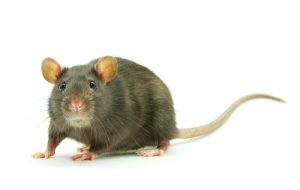How Far Will Rats Roam?
By Chris Williams on January 13, 2012.
Q. We saw what I think was a rat around our garbage cans outside. My wife is totally freaked out that we might have rats. What are the chances that the rat (or rats) are nesting in our yard, or even worse in our garage? We have a two acre lot with a stream at the back end so I’m hoping that the rat lives by the stream, or even farther away, and was just passing through.
A. Our common rat, the brown rat, has an average home range of 25 to 100 feet from its nest. The rat will typically travel that distance at night looking for food and water. Rats living close to available food will have a shorter range, and some unlucky rats will travel several hundred feet each night to find food. Other factors such as the season and population density also affect the home range of a rat population.
You don’t say how rural your surroundings are. Rats that normally live in rural areas or farmland fields may have seasonal migrations, leaving the harvested fields in the fall and moving closer to man and buildings until the spring when they return to the newly planted fields.
 As to how close rat nests might be — like any animal, rats prefer to live close to a reliable food source. Brown rats would not likely be living in your garage, but they could be living under it. Unlike mice, who can build nests almost anywhere inside, brown rats prefer to live outside in dirt burrows. And, they like to dig those burrows under foundations, porches, sidewalks, woodpiles, or at the edge of other large objects on the ground. However, rats are not above entering your garage if food (like a bowl of dog food) is available. If your garbage can area or your garage provides reliable food for them, they will have a burrow as close as they comfortably can. For example, they will often brazenly burrow directly underneath a dumpster – that’s really staying close to your food.
As to how close rat nests might be — like any animal, rats prefer to live close to a reliable food source. Brown rats would not likely be living in your garage, but they could be living under it. Unlike mice, who can build nests almost anywhere inside, brown rats prefer to live outside in dirt burrows. And, they like to dig those burrows under foundations, porches, sidewalks, woodpiles, or at the edge of other large objects on the ground. However, rats are not above entering your garage if food (like a bowl of dog food) is available. If your garbage can area or your garage provides reliable food for them, they will have a burrow as close as they comfortably can. For example, they will often brazenly burrow directly underneath a dumpster – that’s really staying close to your food.
Rats are omnivores, they will eat anything, and they eat about 10% of their weight each day. They begin searching for food shortly after sunset. If you see them in daylight, it’s often an indication of a large rat population with limited food. If the food is in an exposed area or is too large to be eaten quickly, rats will carry it to a hiding place before eating it. Rats will also hoard food to eat later. These food caches can sometimes be found when cleaning garages, sheds, or basements.
Give Colonial a call. Our technicians know rats! We can inspect your property for active rat burrows and other signs of rats, and can trap or bait for rats. Our pest control technicians can also advise you on proper garbage management to avoid further rat problems.
Stay up-to-date with Colonial Pest’s email newsletter!